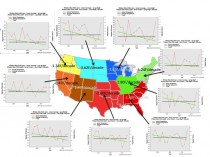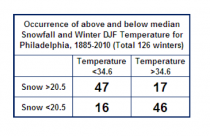See Dr. Richard Keen’s excellent response to the AP story now with graphics here.
Another embarrassing moment for the science brought to you by the AMS, HUFFPO and AP’s Seth Borenstein.
Climate Change And Blizzards May Be Connected, Global Warming Studies Find
With scant snowfall and barren ski slopes in parts of the Midwest and Northeast the past couple of years, some scientists have pointed to global warming as the culprit.
Then when a whopper of a blizzard smacked the Northeast with more than 2 feet of snow in some places earlier this month, some of the same people again blamed global warming.
How can that be? It’s been a joke among skeptics, pointing to what seems to be a brazen contradiction.
But the answer lies in atmospheric physics. A warmer atmosphere can hold, and dump, more moisture, snow experts self annointed but totally clueless say. And two soon-to-be-published studies demonstrate how there can be more giant blizzards yet less snow overall each year. Projections are that that’s likely to continue with man-made global warming.
Consider:
- The United States has been walloped by twice as many of the most extreme snowstorms in the past 50 years than in the previous 60 years, according to an upcoming study on extreme weather by leading federal and university climate scientists. This also fits with a dramatic upward trend in extreme winter precipitation - both rain and snow - in the Northeastern U.S. charted by the National Climatic Data Center.
- Yet the Global Snow Lab at Rutgers University says that spring snow cover in the Northern Hemisphere has shrunk on average by 1 million square miles in the last 45 years.
- And an upcoming study in the AMS Journal of Climate says computer models predict annual global snowfall to shrink by more than a foot in the next 50 years. The study’s author said most people live in parts of the United States that are likely to see annual snowfall drop between 30 and 70 percent by the end of the century. (How sad how fall the AMS has fallen - now just another environmental advocacy group)
“Shorter snow season, less snow overall, but the occasional knockout punch,” Princeton University climate scientist ![]() Michael Oppenheimer said. “That’s the new world we live in.” Oppenheimer was an environmental advocate with the Environmental Defense Fund but went to Princeton to try and legitimize his status - this has happened at many colleges and universities to the detriment of students
Michael Oppenheimer said. “That’s the new world we live in.” Oppenheimer was an environmental advocate with the Environmental Defense Fund but went to Princeton to try and legitimize his status - this has happened at many colleges and universities to the detriment of students
Ten climate scientists say the idea of less snow and more blizzards makes sense: A warmer world is likely to decrease the overall amount of snow falling each year and shrink snow season. But when it is cold enough for a snowstorm to hit, the slightly warmer air is often carrying more moisture, producing potentially historic blizzards.
“Strong snowstorms thrive on the ragged edge of temperature - warm enough for the air to hold lots of moisture, meaning lots of precipitation, but just cold enough for it to fall as snow,” said Mark Serreze, director of the National Snow and Ice Data Center. “Increasingly, it seems that we’re on that ragged edge.” another institutional downgrade
Just look at the last few years in the Northeast. Or take Chicago, which until late January had 335 days without more than an inch of snow. Both have been hit with historic storms in recent years.
Scientists won’t blame a specific event or even a specific seasonal change on global warming without doing intricate and time-consuming studies. And they say they are just now getting a better picture of the complex intersection of man-made climate change and extreme snowfall.
But when Serreze, Oppenheimer and others look at the last few years of less snow overall, punctuated by big storms, they say this is what they are expecting in the future.
“It fits the pattern that we expect to unfold,” Oppenheimer said.
The world is warming so precipitation that would normally fall as snow in the future will likely fall as rain once it gets above the freezing point, said Princeton researcher Sarah Kapnick.
Her study used new computer models failing bigger every dayto simulate the climate in 60 to 100 years as carbon dioxide levels soar. She found large reductions in snowfall throughout much of the world, especially parts of Canada and the Andes Mountains. In the United States, her models predict about a 50 percent or more drop in annual snowfall amounts along a giant swath of the nation from Maine to Texas and the Pacific Northwest and California’s Sierra Nevada mountains.
This is especially important out West where large snowcaps are natural reservoirs for a region’s water supply, Kapnick said. And already in the Cascades of the Pacific Northwest and in much of California, the amount of snow still around on April 1 has been declining so that it’s down about 20 percent compared to 80 years ago, said Philip Mote, who heads a climate change institute at Oregon State University.what a downgrade from George Taylor. Mote has apparently given up on his winter decline of western snowpack theory that got him a seat at the IPCC. He is focusing now on April. This spring reduced snowpack may be explained by lack of volcanic aerosols the last two decades which allows the spring sun to do its thing. More snow has been falling in late fall and winter thanks to the cold PDO since 1998. Recent big snow winters have seen snow persist into summer.
Kapnick says it is snowing about as much as ever in the heart of winter, such as February. But the snow season is getting much shorter, especially in spring and in the northernmost areas, said Rutgers’ David Robinson, a co-author of the study on extreme weather that will be published in the Bulletin of the American Meteorological Society.
The Rutgers snow lab says this January saw the sixth-widest snow cover in the Northern Hemisphere; the United States had an above average snow cover for the last few months. But that’s a misleading statistic, Robinson said, because even though more ground is covered by snow, it’s covered by less snow.
And when those big storms finally hit, there is more than just added moisture in the air, there’s extra moisture coming from the warm ocean, Robinson and Oppenheimer said. And the air is full of energy and unstable, allowing storms to lift yet more moisture up to colder levels. That generates more intense rates of snowfall, Robinson said.”
“If you can tap that moisture and you have that fortuitous collision of moist air and below freezing temperatures, you can pop some big storms,” Robinson said.
As the stories below show, this will join 4 of the top 5 snowiest winters for the hemisphere that fall only behind 1977/78 - 2009/10, 2010/11, 2007/08,. 2002/03) in the last decade. We have had 18 major impact east coast metro snowstorms since 2000, 11 since 2009. The only decade with more major snows was the 1960s, the coldest decade in the last 80 years coming after a two decade warming. Cooling after a warm period is what produces more snows and storms. Winters as shown here have cooled in the last 15 years in all 9 US climate regions.
Dr. Richard Keen has commented in some great detail on the Borenstein piece here and had done a wonderful study here that showed that cold winter produce more snows not warm in Philadelphia.






